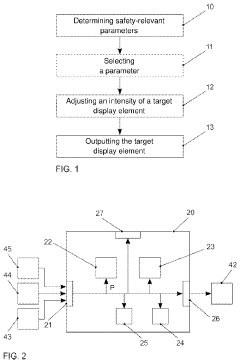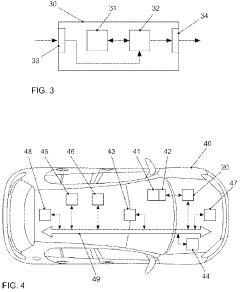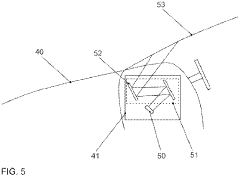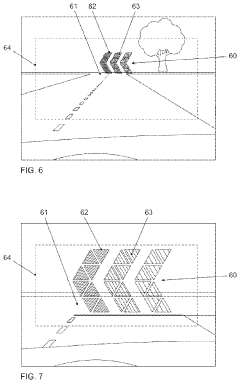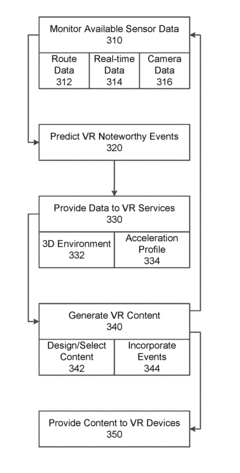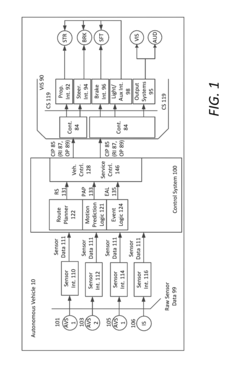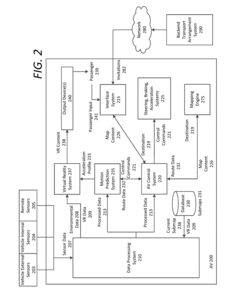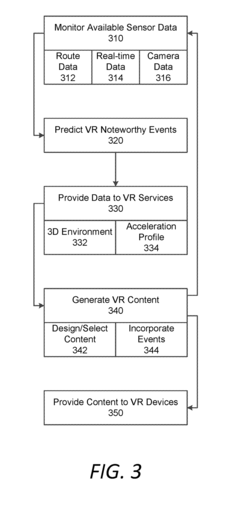V8 Engine Role in Augmented Reality Automotive Technologies
JUL 4, 20259 MIN READ
Generate Your Research Report Instantly with AI Agent
Patsnap Eureka helps you evaluate technical feasibility & market potential.
V8 Engine AR Evolution
The V8 engine has played a significant role in the evolution of augmented reality (AR) technologies in the automotive industry. Initially, the integration of AR in vehicles was limited due to computational constraints. However, as V8 engines became more powerful and efficient, they provided the necessary processing capabilities to support increasingly sophisticated AR applications.
In the early stages, AR in automobiles was primarily focused on basic heads-up displays (HUDs) that projected simple information such as speed and navigation directions onto the windshield. These systems relied on the vehicle's existing onboard computers, which were often underpowered for more complex AR tasks.
As V8 engines evolved, they incorporated more advanced electronic control units (ECUs) and sensors. This development allowed for the integration of more powerful onboard computers capable of processing real-time data from multiple sources. Consequently, AR systems in vehicles began to offer more dynamic and interactive features, such as highlighting road hazards and displaying real-time traffic information.
The introduction of direct injection and turbocharging in V8 engines not only improved fuel efficiency but also enabled the implementation of more sophisticated engine management systems. These systems generated vast amounts of data that could be utilized by AR applications to provide drivers with detailed performance metrics and predictive maintenance information.
Furthermore, the refinement of V8 engines led to reduced vibration and noise, creating a more stable platform for AR hardware such as cameras and sensors. This stability was crucial for ensuring the accuracy and reliability of AR overlays, particularly in high-performance driving scenarios.
As V8 engines became more compact and efficient, they freed up space within the vehicle for additional computing hardware. This allowed for the integration of dedicated AR processors and graphics units, enabling more complex and visually impressive AR experiences without compromising engine performance.
The latest generation of V8 engines, equipped with advanced telemetry and connectivity features, has paved the way for cloud-augmented AR systems. These systems can leverage both onboard processing power and cloud computing resources to deliver highly sophisticated AR experiences, such as real-time 3D mapping and predictive driving assistance.
In conclusion, the evolution of V8 engines has been instrumental in advancing AR technologies in automobiles. From providing the necessary computational power to creating a stable platform for sensors, V8 engines have continually pushed the boundaries of what is possible in automotive AR applications, setting the stage for future innovations in this rapidly evolving field.
In the early stages, AR in automobiles was primarily focused on basic heads-up displays (HUDs) that projected simple information such as speed and navigation directions onto the windshield. These systems relied on the vehicle's existing onboard computers, which were often underpowered for more complex AR tasks.
As V8 engines evolved, they incorporated more advanced electronic control units (ECUs) and sensors. This development allowed for the integration of more powerful onboard computers capable of processing real-time data from multiple sources. Consequently, AR systems in vehicles began to offer more dynamic and interactive features, such as highlighting road hazards and displaying real-time traffic information.
The introduction of direct injection and turbocharging in V8 engines not only improved fuel efficiency but also enabled the implementation of more sophisticated engine management systems. These systems generated vast amounts of data that could be utilized by AR applications to provide drivers with detailed performance metrics and predictive maintenance information.
Furthermore, the refinement of V8 engines led to reduced vibration and noise, creating a more stable platform for AR hardware such as cameras and sensors. This stability was crucial for ensuring the accuracy and reliability of AR overlays, particularly in high-performance driving scenarios.
As V8 engines became more compact and efficient, they freed up space within the vehicle for additional computing hardware. This allowed for the integration of dedicated AR processors and graphics units, enabling more complex and visually impressive AR experiences without compromising engine performance.
The latest generation of V8 engines, equipped with advanced telemetry and connectivity features, has paved the way for cloud-augmented AR systems. These systems can leverage both onboard processing power and cloud computing resources to deliver highly sophisticated AR experiences, such as real-time 3D mapping and predictive driving assistance.
In conclusion, the evolution of V8 engines has been instrumental in advancing AR technologies in automobiles. From providing the necessary computational power to creating a stable platform for sensors, V8 engines have continually pushed the boundaries of what is possible in automotive AR applications, setting the stage for future innovations in this rapidly evolving field.
AR Automotive Market Demand
The augmented reality (AR) automotive market is experiencing significant growth and transformation, driven by increasing consumer demand for advanced in-vehicle technologies and enhanced driving experiences. As vehicles become more connected and intelligent, AR applications are emerging as a key differentiator in the automotive industry, offering innovative solutions for navigation, safety, and entertainment.
Market research indicates a robust growth trajectory for AR automotive technologies. The global AR in automotive market is projected to expand at a compound annual growth rate (CAGR) of over 30% in the coming years. This growth is fueled by the rising adoption of advanced driver assistance systems (ADAS) and the increasing integration of AR-based head-up displays (HUDs) in vehicles across various segments.
Consumer demand for AR automotive technologies is primarily driven by the desire for improved safety features and enhanced driving experiences. AR-enabled navigation systems, which overlay directional information and points of interest onto the real-world view, are particularly popular among consumers. These systems provide more intuitive guidance and reduce driver distraction, addressing a key concern in the automotive industry.
The automotive industry is also witnessing a growing demand for AR-based infotainment systems. These systems offer immersive entertainment experiences for passengers, including interactive gaming and multimedia content. As autonomous driving technologies advance, the demand for in-vehicle entertainment is expected to surge, further boosting the AR automotive market.
Safety-focused AR applications are another area of significant market demand. AR-enabled windshields and displays can highlight potential hazards, display critical vehicle information, and provide real-time alerts to drivers. This technology is particularly valued in adverse weather conditions or low-visibility environments, enhancing overall road safety.
The commercial vehicle sector is also showing increased interest in AR technologies. Fleet management companies are exploring AR solutions for improved logistics, maintenance scheduling, and driver training. This expanding application in the commercial segment is expected to contribute substantially to the overall market growth.
Geographically, North America and Europe are currently leading in AR automotive technology adoption, driven by high consumer awareness and the presence of major automotive manufacturers investing heavily in AR research and development. However, the Asia-Pacific region is expected to witness the fastest growth in the coming years, propelled by rapid technological advancements and increasing disposable incomes in countries like China and India.
As the automotive industry continues to evolve towards more connected and autonomous vehicles, the demand for AR technologies is expected to intensify. This trend is likely to drive further innovation and competition among automotive manufacturers and technology providers, ultimately benefiting consumers with more advanced and integrated AR solutions in their vehicles.
Market research indicates a robust growth trajectory for AR automotive technologies. The global AR in automotive market is projected to expand at a compound annual growth rate (CAGR) of over 30% in the coming years. This growth is fueled by the rising adoption of advanced driver assistance systems (ADAS) and the increasing integration of AR-based head-up displays (HUDs) in vehicles across various segments.
Consumer demand for AR automotive technologies is primarily driven by the desire for improved safety features and enhanced driving experiences. AR-enabled navigation systems, which overlay directional information and points of interest onto the real-world view, are particularly popular among consumers. These systems provide more intuitive guidance and reduce driver distraction, addressing a key concern in the automotive industry.
The automotive industry is also witnessing a growing demand for AR-based infotainment systems. These systems offer immersive entertainment experiences for passengers, including interactive gaming and multimedia content. As autonomous driving technologies advance, the demand for in-vehicle entertainment is expected to surge, further boosting the AR automotive market.
Safety-focused AR applications are another area of significant market demand. AR-enabled windshields and displays can highlight potential hazards, display critical vehicle information, and provide real-time alerts to drivers. This technology is particularly valued in adverse weather conditions or low-visibility environments, enhancing overall road safety.
The commercial vehicle sector is also showing increased interest in AR technologies. Fleet management companies are exploring AR solutions for improved logistics, maintenance scheduling, and driver training. This expanding application in the commercial segment is expected to contribute substantially to the overall market growth.
Geographically, North America and Europe are currently leading in AR automotive technology adoption, driven by high consumer awareness and the presence of major automotive manufacturers investing heavily in AR research and development. However, the Asia-Pacific region is expected to witness the fastest growth in the coming years, propelled by rapid technological advancements and increasing disposable incomes in countries like China and India.
As the automotive industry continues to evolve towards more connected and autonomous vehicles, the demand for AR technologies is expected to intensify. This trend is likely to drive further innovation and competition among automotive manufacturers and technology providers, ultimately benefiting consumers with more advanced and integrated AR solutions in their vehicles.
V8 Engine AR Challenges
The integration of V8 engines with Augmented Reality (AR) technologies in automotive applications presents several significant challenges. One of the primary obstacles is the real-time synchronization between the engine's performance data and the AR display. The high-speed operation of V8 engines requires extremely low-latency data transmission and processing to ensure that the AR overlay accurately reflects the current engine state.
Another challenge lies in the development of robust sensors and data collection systems capable of withstanding the harsh environment of a V8 engine. These systems must operate reliably under extreme temperatures, vibrations, and electromagnetic interference while providing precise measurements for AR integration.
The complexity of V8 engine dynamics also poses difficulties in creating accurate AR models. The intricate interplay of multiple cylinders, valves, and other components necessitates sophisticated algorithms to generate realistic and informative AR visualizations. This challenge is compounded by the need to account for variations in engine performance under different operating conditions and driving scenarios.
Data interpretation and meaningful visualization present another hurdle. Translating raw engine data into intuitive AR displays that enhance driver understanding and decision-making requires careful consideration of human factors and cognitive load. Designers must strike a balance between providing comprehensive information and avoiding information overload that could distract the driver.
The integration of AR systems with existing vehicle electronics and control units is a significant technical challenge. Ensuring seamless communication between the AR system and the engine control unit (ECU) without compromising vehicle safety or performance is crucial. This integration must also comply with stringent automotive industry standards and regulations.
Power management and heat dissipation for AR hardware in the confined space of a vehicle interior present additional challenges. The high-performance computing required for real-time AR processing generates substantial heat, which must be effectively managed to ensure system reliability and longevity.
Finally, the development of user-friendly interfaces that allow drivers to interact with AR displays safely while operating a powerful V8 engine requires innovative input methods and interface designs. These must be intuitive enough for quick adoption but also robust enough to prevent accidental inputs during high-performance driving scenarios.
Addressing these challenges will require collaborative efforts between automotive engineers, AR specialists, and human-machine interface experts to create seamless, safe, and effective AR implementations for V8-powered vehicles.
Another challenge lies in the development of robust sensors and data collection systems capable of withstanding the harsh environment of a V8 engine. These systems must operate reliably under extreme temperatures, vibrations, and electromagnetic interference while providing precise measurements for AR integration.
The complexity of V8 engine dynamics also poses difficulties in creating accurate AR models. The intricate interplay of multiple cylinders, valves, and other components necessitates sophisticated algorithms to generate realistic and informative AR visualizations. This challenge is compounded by the need to account for variations in engine performance under different operating conditions and driving scenarios.
Data interpretation and meaningful visualization present another hurdle. Translating raw engine data into intuitive AR displays that enhance driver understanding and decision-making requires careful consideration of human factors and cognitive load. Designers must strike a balance between providing comprehensive information and avoiding information overload that could distract the driver.
The integration of AR systems with existing vehicle electronics and control units is a significant technical challenge. Ensuring seamless communication between the AR system and the engine control unit (ECU) without compromising vehicle safety or performance is crucial. This integration must also comply with stringent automotive industry standards and regulations.
Power management and heat dissipation for AR hardware in the confined space of a vehicle interior present additional challenges. The high-performance computing required for real-time AR processing generates substantial heat, which must be effectively managed to ensure system reliability and longevity.
Finally, the development of user-friendly interfaces that allow drivers to interact with AR displays safely while operating a powerful V8 engine requires innovative input methods and interface designs. These must be intuitive enough for quick adoption but also robust enough to prevent accidental inputs during high-performance driving scenarios.
Addressing these challenges will require collaborative efforts between automotive engineers, AR specialists, and human-machine interface experts to create seamless, safe, and effective AR implementations for V8-powered vehicles.
V8 AR Current Solutions
01 V8 Engine Design and Configuration
V8 engines are designed with eight cylinders arranged in two banks of four, forming a V-shape. This configuration allows for a compact design, improved power output, and better balance compared to inline engines. Various aspects of V8 engine design, including cylinder arrangement, crankshaft configuration, and valve timing, are continuously optimized to enhance performance and efficiency.- V8 Engine Design and Configuration: V8 engines are characterized by their V-shaped cylinder arrangement, typically with four cylinders on each side. This design offers a balance between power output and compact size, making it popular in high-performance vehicles and trucks. The configuration allows for improved engine balance and smoother operation compared to inline engines.
- Fuel Efficiency and Emissions Control: Modern V8 engines incorporate various technologies to improve fuel efficiency and reduce emissions. These may include variable valve timing, direct fuel injection, cylinder deactivation, and advanced exhaust gas recirculation systems. Such innovations help V8 engines meet stringent environmental regulations while maintaining performance.
- Performance Enhancement Technologies: V8 engines often feature performance-enhancing technologies such as turbocharging, supercharging, and advanced cooling systems. These technologies increase power output and torque, allowing for improved acceleration and overall performance. Additionally, electronic engine management systems optimize fuel delivery and ignition timing for maximum efficiency and power.
- Lightweight Materials and Construction: To improve power-to-weight ratios and overall efficiency, modern V8 engines often utilize lightweight materials such as aluminum alloys for engine blocks and cylinder heads. Advanced manufacturing techniques, including precision casting and forging, are employed to create stronger, lighter engine components that can withstand high stresses and temperatures.
- Lubrication and Cooling Systems: V8 engines require sophisticated lubrication and cooling systems to maintain optimal performance and longevity. These may include high-capacity oil pumps, advanced oil filtration systems, and efficient coolant circulation methods. Some designs incorporate dry sump lubrication for improved oil control in high-performance applications.
02 Fuel Efficiency and Emissions Control
Modern V8 engines incorporate advanced technologies to improve fuel efficiency and reduce emissions. These may include direct fuel injection, variable valve timing, cylinder deactivation, and advanced exhaust gas recirculation systems. Manufacturers are focusing on developing V8 engines that meet stringent environmental regulations while maintaining high performance characteristics.Expand Specific Solutions03 Performance Enhancement and Tuning
Various methods and components are used to enhance V8 engine performance. These include turbocharging, supercharging, intercooling, and optimizing intake and exhaust systems. Engine management systems and electronic control units are also crucial in fine-tuning engine parameters for maximum power output and efficiency.Expand Specific Solutions04 Cooling and Lubrication Systems
Effective cooling and lubrication are critical for V8 engine reliability and longevity. Advanced cooling systems may include precision-controlled electric water pumps, improved radiator designs, and optimized coolant flow paths. Lubrication systems focus on efficient oil distribution, filtration, and temperature management to protect engine components under high-performance conditions.Expand Specific Solutions05 Manufacturing and Assembly Techniques
Innovative manufacturing and assembly techniques are employed in V8 engine production to improve quality, reduce weight, and enhance durability. These may include advanced casting methods, precision machining, and the use of lightweight materials such as aluminum alloys. Assembly processes are often automated and incorporate rigorous quality control measures to ensure consistent performance and reliability.Expand Specific Solutions
AR Automotive Key Players
The V8 Engine's role in Augmented Reality (AR) Automotive Technologies is at an early stage of development, with the market showing significant growth potential. The technology's maturity varies among key players, with companies like Volkswagen AG, Hyundai Motor Co., and Mercedes-Benz Group AG leading in integration efforts. As the automotive industry shifts towards more immersive and interactive experiences, the market size for AR technologies is expected to expand rapidly. Companies such as Magic Leap, Inc. and Medivis, Inc. are contributing to the advancement of AR solutions, while traditional automakers are increasingly investing in this space to enhance driver experience and safety features.
Volkswagen AG
Technical Solution: Volkswagen AG has developed an advanced Augmented Reality (AR) system for their vehicles, leveraging the V8 Engine to enhance the driving experience. Their solution integrates a high-performance V8 engine with AR technology to provide real-time information and navigation assistance. The system uses the engine's data to display performance metrics, fuel efficiency, and maintenance alerts in the driver's field of view. Additionally, it incorporates road and traffic information, projecting navigation cues and potential hazards onto the windshield[1]. The V8 engine's power and responsiveness are utilized to ensure smooth operation of the AR system, even in demanding driving conditions[3].
Strengths: Seamless integration of powerful V8 engine with AR technology, enhancing both performance and safety. Weaknesses: High cost of implementation and potential for driver distraction if not carefully designed.
Mercedes-Benz Group AG
Technical Solution: Mercedes-Benz Group AG has pioneered an innovative AR system that works in tandem with their V8 engines. Their technology, known as MBUX Augmented Reality Navigation, uses the V8 engine's precise positioning and motion data to create an immersive AR experience. The system overlays navigation information, such as turning arrows and street names, directly onto a live video feed of the road ahead displayed on the central screen[2]. The V8 engine's advanced sensors and processing capabilities are utilized to ensure accurate positioning and real-time updates. Furthermore, the system integrates with the vehicle's advanced driver assistance features, providing AR warnings for potential hazards and displaying optimal driving lines[4].
Strengths: Highly accurate and responsive AR system due to integration with V8 engine data. Comprehensive feature set including navigation and safety alerts. Weaknesses: Reliance on central screen rather than heads-up display may require drivers to look away from the road.
V8 AR Core Innovations
Control of a display on an augmented reality head-up display device for a vehicle
PatentActiveUS11817064B2
Innovation
- A method and device for controlling the augmented reality head-up display that adjusts the intensity and size of display elements based on safety-relevant parameters such as distance to a target element and time to collision, ensuring that critical information remains visible and occlusion is minimized.
Virtual reality experience for a vehicle
PatentActiveUS20180040162A1
Innovation
- A virtual reality system that utilizes motion prediction and sensor data to minimize the impact of external stimuli, providing riders with enhanced views and situational awareness by using AV sensors to predict future motion trajectories and internal sensors to monitor passenger positions, while leveraging AV computing resources for improved graphics and content rendering.
V8 AR Safety Standards
The integration of V8 engines with Augmented Reality (AR) technologies in automotive applications necessitates the development and implementation of robust safety standards. These standards are crucial to ensure the safe operation of vehicles equipped with advanced AR systems, particularly those powered by high-performance V8 engines.
One of the primary concerns addressed by V8 AR safety standards is the potential for driver distraction. AR displays, when combined with the power of a V8 engine, could potentially overwhelm or divert the driver's attention from critical road conditions. To mitigate this risk, standards have been established to limit the amount and type of information presented through AR interfaces, especially during high-speed driving scenarios typical of V8-powered vehicles.
Another key aspect of these safety standards is the integration of AR systems with existing vehicle safety features. For V8 engines, which often deliver significant power and torque, it is essential that AR systems work seamlessly with traction control, stability management, and advanced driver assistance systems (ADAS). Standards have been developed to ensure that AR overlays do not interfere with or contradict these critical safety systems, particularly during high-performance driving situations.
The standards also address the unique challenges posed by the vibration and heat generated by V8 engines. AR hardware components must be designed and tested to withstand these conditions without compromising performance or safety. This includes rigorous testing protocols for AR display units, sensors, and processing hardware to ensure they can function reliably in the demanding environment of a V8-powered vehicle.
Furthermore, V8 AR safety standards encompass guidelines for the calibration and alignment of AR systems. Given the precision required for accurate AR overlays, especially at high speeds, these standards outline procedures for initial setup and ongoing maintenance of AR systems in V8-equipped vehicles. This includes regular recalibration requirements to account for changes in vehicle dynamics over time.
The standards also address the potential for AR systems to enhance safety in V8-powered vehicles. This includes specifications for AR-enhanced night vision, real-time obstacle detection, and dynamic route guidance that takes into account the performance capabilities of V8 engines. By leveraging the power of AR, these features aim to improve driver awareness and reaction times, particularly in high-speed or challenging driving conditions.
Lastly, V8 AR safety standards include provisions for fail-safe mechanisms and redundancy in critical AR components. Given the high-performance nature of V8 engines, it is crucial that AR systems can gracefully degrade or shut down without compromising vehicle control or driver safety. These standards outline requirements for backup systems, error handling protocols, and driver alert mechanisms in case of AR system malfunction.
One of the primary concerns addressed by V8 AR safety standards is the potential for driver distraction. AR displays, when combined with the power of a V8 engine, could potentially overwhelm or divert the driver's attention from critical road conditions. To mitigate this risk, standards have been established to limit the amount and type of information presented through AR interfaces, especially during high-speed driving scenarios typical of V8-powered vehicles.
Another key aspect of these safety standards is the integration of AR systems with existing vehicle safety features. For V8 engines, which often deliver significant power and torque, it is essential that AR systems work seamlessly with traction control, stability management, and advanced driver assistance systems (ADAS). Standards have been developed to ensure that AR overlays do not interfere with or contradict these critical safety systems, particularly during high-performance driving situations.
The standards also address the unique challenges posed by the vibration and heat generated by V8 engines. AR hardware components must be designed and tested to withstand these conditions without compromising performance or safety. This includes rigorous testing protocols for AR display units, sensors, and processing hardware to ensure they can function reliably in the demanding environment of a V8-powered vehicle.
Furthermore, V8 AR safety standards encompass guidelines for the calibration and alignment of AR systems. Given the precision required for accurate AR overlays, especially at high speeds, these standards outline procedures for initial setup and ongoing maintenance of AR systems in V8-equipped vehicles. This includes regular recalibration requirements to account for changes in vehicle dynamics over time.
The standards also address the potential for AR systems to enhance safety in V8-powered vehicles. This includes specifications for AR-enhanced night vision, real-time obstacle detection, and dynamic route guidance that takes into account the performance capabilities of V8 engines. By leveraging the power of AR, these features aim to improve driver awareness and reaction times, particularly in high-speed or challenging driving conditions.
Lastly, V8 AR safety standards include provisions for fail-safe mechanisms and redundancy in critical AR components. Given the high-performance nature of V8 engines, it is crucial that AR systems can gracefully degrade or shut down without compromising vehicle control or driver safety. These standards outline requirements for backup systems, error handling protocols, and driver alert mechanisms in case of AR system malfunction.
V8 AR User Experience
The V8 AR User Experience in augmented reality automotive technologies represents a significant leap forward in enhancing driver interaction and safety. By leveraging the power of V8 engines and integrating augmented reality (AR) capabilities, this technology creates an immersive and informative driving environment.
The V8 AR system projects crucial information directly onto the windshield, creating a heads-up display that allows drivers to maintain focus on the road while accessing vital data. This seamless integration of real-world visuals and digital overlays provides a more intuitive and less distracting interface compared to traditional dashboard displays.
One of the key features of the V8 AR User Experience is its ability to highlight potential hazards and obstacles in real-time. Using advanced sensors and computer vision algorithms, the system can detect and outline pedestrians, cyclists, and other vehicles, enhancing situational awareness and reducing the risk of accidents.
Navigation is greatly improved through the V8 AR interface. Turn-by-turn directions are overlaid onto the actual road, making it easier for drivers to understand and follow routes. Points of interest, such as gas stations or restaurants, can be displayed with relevant information, allowing for quick decision-making without taking eyes off the road.
The system also provides real-time performance data related to the V8 engine. Drivers can view information such as speed, RPM, fuel efficiency, and engine temperature through AR displays, eliminating the need to glance down at traditional gauges. This integration of performance metrics with AR technology creates a more engaging and informative driving experience.
Adaptive displays are another crucial aspect of the V8 AR User Experience. The system can adjust the information presented based on driving conditions, speed, and user preferences. For instance, it may display more detailed engine performance data during high-speed driving or emphasize navigation information in unfamiliar areas.
The V8 AR technology also enhances the overall aesthetics of the driving experience. It can create visually stunning effects that complement the power and performance of the V8 engine, such as dynamic exhaust visualizations or performance mode indicators, adding an element of excitement to the drive.
Furthermore, the V8 AR User Experience extends beyond the driver to enhance passenger engagement. Passengers can access interactive AR displays providing information about the journey, surrounding landmarks, or entertainment options, creating a more immersive travel experience for all occupants.
The V8 AR system projects crucial information directly onto the windshield, creating a heads-up display that allows drivers to maintain focus on the road while accessing vital data. This seamless integration of real-world visuals and digital overlays provides a more intuitive and less distracting interface compared to traditional dashboard displays.
One of the key features of the V8 AR User Experience is its ability to highlight potential hazards and obstacles in real-time. Using advanced sensors and computer vision algorithms, the system can detect and outline pedestrians, cyclists, and other vehicles, enhancing situational awareness and reducing the risk of accidents.
Navigation is greatly improved through the V8 AR interface. Turn-by-turn directions are overlaid onto the actual road, making it easier for drivers to understand and follow routes. Points of interest, such as gas stations or restaurants, can be displayed with relevant information, allowing for quick decision-making without taking eyes off the road.
The system also provides real-time performance data related to the V8 engine. Drivers can view information such as speed, RPM, fuel efficiency, and engine temperature through AR displays, eliminating the need to glance down at traditional gauges. This integration of performance metrics with AR technology creates a more engaging and informative driving experience.
Adaptive displays are another crucial aspect of the V8 AR User Experience. The system can adjust the information presented based on driving conditions, speed, and user preferences. For instance, it may display more detailed engine performance data during high-speed driving or emphasize navigation information in unfamiliar areas.
The V8 AR technology also enhances the overall aesthetics of the driving experience. It can create visually stunning effects that complement the power and performance of the V8 engine, such as dynamic exhaust visualizations or performance mode indicators, adding an element of excitement to the drive.
Furthermore, the V8 AR User Experience extends beyond the driver to enhance passenger engagement. Passengers can access interactive AR displays providing information about the journey, surrounding landmarks, or entertainment options, creating a more immersive travel experience for all occupants.
Unlock deeper insights with Patsnap Eureka Quick Research — get a full tech report to explore trends and direct your research. Try now!
Generate Your Research Report Instantly with AI Agent
Supercharge your innovation with Patsnap Eureka AI Agent Platform!
